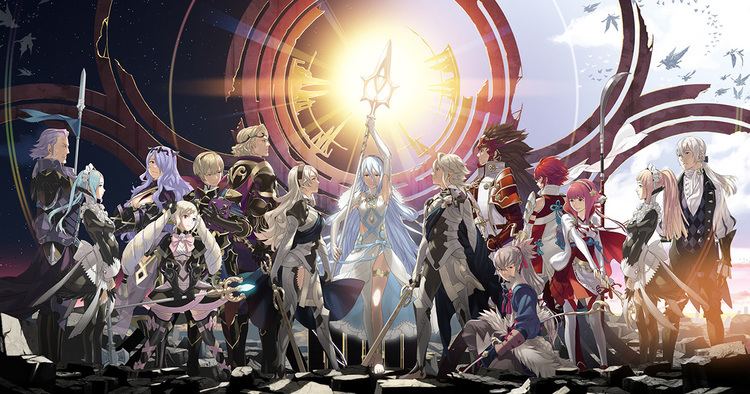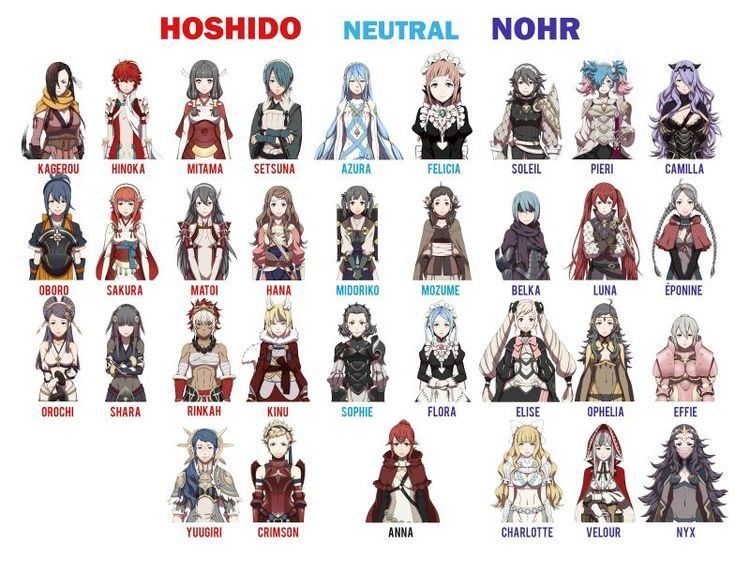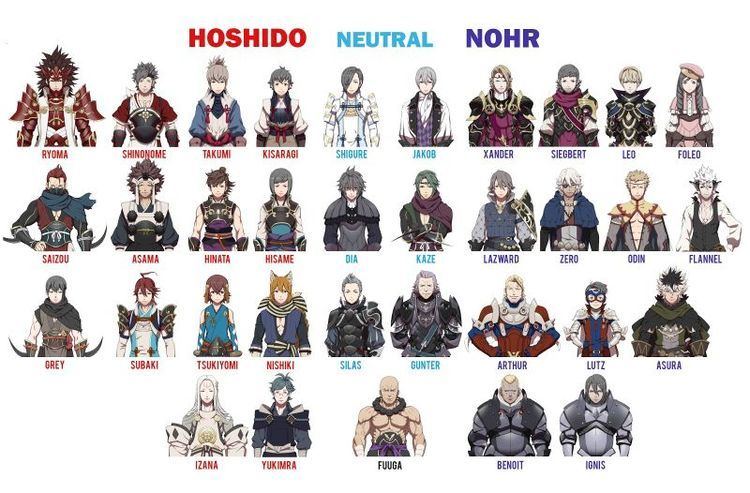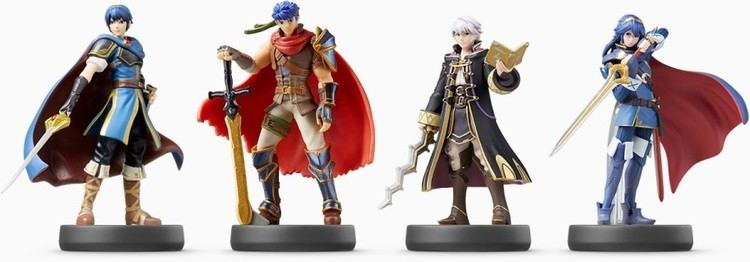Platform of origin Family Computer Publisher Nintendo | ||
 | ||
Platforms Family Computer, Game Boy Advance, GameCube, Nintendo DS, Nintendo 3DS, Nintendo Switch, Satellaview, Super Famicom, Wii, Wii U, Android, iOS First release Fire Emblem: Shadow Dragon and the Blade of LightApril 20, 1990 Genres Tactical role-playing game, Turn-based strategy Games Fire Emblem Heroes, Tokyo Mirage Sessions, Fire Emblem Fates, Fire Emblem Awakening, Fire Emblem: Shin Mon | ||
Evolution of fire emblem
Fire Emblem (ファイアーエムブレム, Faiā Emuburemu) is a tactical role-playing video game franchise developed by Intelligent Systems and published by Nintendo. First produced and published for the Family Computer (Famicom), the series consists of fifteen games, including remakes, across multiple game systems. Described by its creators as an "RPG simulation", the gameplay revolves around tactical movement of characters across grid-based environments, while incorporating a story and characters similar to those in a more traditional role-playing video game.
Contents
- Evolution of fire emblem
- Fire emblem heroes easy allies review
- Games
- Main series
- Remakes and spin offs
- Related media
- Setting
- Gameplay
- Development
- Reception
- Tear Ring Saga lawsuit
- References

A noted aspect of gameplay is the permanent death of characters in battle, removing them from the rest of the game should they be defeated. The series title refers to the titular object, the "Fire Emblem", usually portrayed as a royally treasured weapon or shield, representing the power of war and dragons, a recurring element in the series. Development of the first game began as a dōjin project by Shouzou Kaga and three other developers. Its success prompted the development of further titles in the series. Kaga headed development of each entry until the release of Thracia 776, when he left the company and founded his own game studio to develop Tear Ring Saga.

No games in the series were released outside of Japan until two characters, Marth and Roy, were included as playable characters in the 2001 fighting game Super Smash Bros. Melee. Their popularity eventually convinced Nintendo to release the next game, The Blazing Blade, in western regions under the title Fire Emblem in 2003. Many games in the series have sold well, despite a decline during the 2000s which resulted in the series' near-cancellation. Individual entries have generally been praised, and the series as a whole has been praised for its gameplay, and it is cited as the origin of the tactical role-playing genre. Characters from multiple games have also been included in crossovers with other franchises.

Fire emblem heroes easy allies review
Games

According to a developer interview with the developers of Fire Emblem Fates, there are currently fifteen games in the Fire Emblem series, including remakes of earlier titles. The official Fire Emblem World portal lists thirteen games, excluding Fates. Counting only original titles, there have been twelve games in the series including Fates. A game was initially in development for the Nintendo 64 and its peripheral 64DD. Originally codenamed Fire Emblem 64, it was first revealed by Shigeru Miyamoto in 1997. Ultimately, due to poor sales for the 64DD and internal structural changes at Intelligent Systems, Fire Emblem 64 was cancelled in 2000 and development shifted to what would become Fire Emblem: The Binding Blade. It was speculated, and later confirmed by staff, that the work done for Fire Emblem 64 was incorporated into Binding Blade. A different title for the Wii was planned, but after some trial and error, in addition to an unfocused development schedule, the project was cancelled. No original Fire Emblem title is currently planned for the Wii U, and Nintendo producer Hitoshi Yamagami said such a game would need to sell 700,000 copies to be profitable.
Main series
The first entry in the series, Shadow Dragon and the Blade of Light, was released in 1990 for the Japanese Family Computer, introducing the basic series mechanics. A second title for the Famicom set during the events of the first game, Fire Emblem Gaiden, released in 1992. In 1994, Mystery of the Emblem was released for the Super Famicom, containing both a remake of Shadow Dragon and the Blade of Light and a sequel continuing the story of the first game. Two more games were released for the Super Famicom in 1996 and 1999 respectively: Genealogy of the Holy War and Thracia 776.
The next entry released was Binding Blade in 2002 for the Game Boy Advance, originally announced as Maiden of the Dark. A prequel to Binding Blade, The Sword of Flame, was released for the Game Boy Advance the following year. This entry was released overseas under the title Fire Emblem. It was released in 2003 in North America and 2004 in Europe. The final entry for the Game Boy Advance, The Sacred Stones, was released in 2004 in Japan, and 2005 in North America and Europe.
The next entry in the series, Path of Radiance, was released on the GameCube worldwide in 2005. It was the first Fire Emblem to feature 3D graphics, voice acting, and full-motion animated cutscenes. A direct sequel to Path of Radiance, Radiant Dawn was released for the Wii in 2007 in Japan and North America, and 2008 in Europe.
The next entry in the series, Awakening for the Nintendo 3DS, was released in 2012 in Japan and 2013 in North America and Europe. The second entry for the 3DS, Fates, was released in June 2015 in Japan, February 2016 in North America and in May 2016 for Europe and Australia. It comes in multiple versions: two physical versions titled Birthright and Conquest, and a third route titled Revelation released as downloadable content. A new mainline title for the Nintendo Switch is also in development, planned for a 2018 release.
Remakes and spin-offs
An expanded remake of the first game, titled Fire Emblem: Shadow Dragon, was released for the Nintendo DS in 2008 in Japan and Europe, and 2009 in North America. Restoring content cut from the first game when it was remade in Mystery of the Emblem, the game makes use of the DS' gameplay functions and includes additional story elements. A second remake for the DS was released in 2010. Titled New Mystery of the Emblem, it was an expanded remake similar to Shadow Dragon, and did not receive a western release. A remake of Gaiden, titled Fire Emblem Echoes: Shadows of Valentia, is set for worldwide release on the 3DS in 2017.
In 1997, an episodic prequel to Mystery of the Emblem titled BS Fire Emblem were released through Satellaview. The events of Archanea Senki were included in the remake of Mystery of the Emblem. Characters from the Fire Emblem series have been included in multiple entries in the Super Smash Bros. series, beginning with main protagonists Marth and Roy in Super Smash Bros. Melee. Characters from Awakening also appeared in Intelligent System's strategy game Code Name: S.T.E.A.M. as optional characters. A crossover with the Shin Megami Tensei series, titled Tokyo Mirage Sessions ♯FE, was released in December 2015 in Japan and worldwide in June 2016. A crossover mobile spin-off titled Fire Emblem Heroes, was released on February 2, 2017 for mobile devices. A crossover with the Dynasty Warriors series, Fire Emblem Warriors, was announced in January 2017 and will be released for the New Nintendo 3DS and Nintendo Switch.
Related media
A short original video animation series based on Mystery of the Emblem was created in 1997. These anime episodes were released in North America, six years before The Sword of Flame was localized. Amiibo figures based on Fire Emblem characters were produced, which are compatible with Fates, Code Name: S.T.E.A.M. and Super Smash Bros. for Nintendo 3DS and Wii U. Manga based on the games have also been produced, including Binding Blade and Awakening. A trading card game, titled Fire Emblem 0 (Cipher), based on the series is also available in Japan, featuring character artwork by old and new artists.
Setting
The Fire Emblem games take place across multiple unrelated settings within a Medieval or Renaissance-themed time period, with the story general focused on the main protagonist, usually a member of royalty, caught in the conflict of two or more countries across a continent and fighting for their cause before having to defeat the game's final boss, who is either an evil dragon, tyrant or dark god hell-bent on destroying the main character's homeland if not the world and humanity itself. The continents of Archanea and Valentia are the settings of Shadow Dragon and the Blade of Light, Gaiden, Mystery of the Emblem and Awakening, with Awakening taking place several millennia after the other games. It was also the planned setting for Fire Emblem 64. Genealogy of the Holy War and Thracia 776 are set in the land of Jugdral, while Fire Emblem and Binding Blade take place in Elibe. The Sacred Stones is set in the land of Magvel. Path of Radiance and Radiant Dawn are set on the continent of Tellius.
A recurring element in the series is the titular Fire Emblem, an object with magical powers. In Shadow Dragon and the Blade of Light, it is a shield inset with five magical gems. Its name derives from its connection to dragons and weapons of war, being the "emblem of flame". It also appears as a family crest in the continuity of Genealogy of the Holy War, a family seal in The Binding Blade storyline, a magical gemstone in The Sacred Stones, and in the Path of Radiance world it takes the form of a bronze medallion holding a goddess of chaos. Other magical elements, including feuding gods and conflict with mystical species such as dragons and shape-shifters are also recurring elements in the series.
Gameplay
The Fire Emblem series has been described by its developers as an "RPG simulation", combining tactical simulation gameplay with the plot and character development of a role-playing game, creating a sense of connection with characters in the field not present in previous tactical games. Battles in the Fire Emblem series play out on a grid-based map, with the player controlling a set number of characters across maps tied to both the game's story and optional side stories. Each character has a specific character class, giving them set abilities and affecting how far they can move across the field. Some character classes have innate skills unique to them, and each character has its own class and stats. Depending on the series entry, a character's class can be changed or upgraded with or without special items. During battle, each character gains experience points by performing actions, such as attacking an enemy, healing an ally, and slaying a foe (which typically offers the most experience points). When a certain level is reached, the character levels up, and new skill points are awarded randomly to a character's attributes, be they the character's maximum health, agility or strength. The more a character is used in battle, the more experience that character gains.
A key element in combat since Genealogy of the Holy War is the Weapon Triangle, a system governing the strengths and weaknesses certain weapons and types of magic have against each other in a Scissors, Paper, Rock fashion. For weapons, lances are stronger than swords, swords are stronger than axes, and axes are stronger than lances. In magic, fire is stronger than wind, wind is stronger than thunder, and thunder is stronger than fire. For Fates, the Weapon Triangle relationships add other weapons in the following way: swords and tomes are stronger than axes and bows, axes and bows were stronger than lances and shuriken, lances and shuriken are stronger than swords and tomes, and so on. Several games use a Weapon Durability system: after being used a certain number of times, a character's weapon will break. Different entries have various systems related to character weapons: in Genealogy of the Holy War, weapons can be repaired at special shops; in Path of Radiance and future games, weapons can be bought and upgraded, while the durability system is replaced in Fates with a system where more powerful weapons weaken some of a wielder's stats.
Both inside and outside battle, characters' relationships can be developed through interactions on and off the battlefield. As the strength of their relationships grow, certain abilities in battle are also strengthened. A feature introduced in Genealogy of the Holy War and used in later titles was an aspect of relationships. A man and woman who fall in love will have a child, and that child will inherit certain skills and stats from them. One of the recurring features in the series is permanent death, a function in which units defeated in battle are permanently removed from the rest of the game with very few exceptions (the main character, a character pivotal to the main story). Up until Fire Emblem: New Mystery of the Emblem: Heroes of Light and Shadow, there was no option to disable permanent death. In New Mystery of the Emblem, a new Casual Mode was added, in which characters that died were revived at the end of a battle. Fates also added Phoenix Mode, where characters slain during one turn are revived on the player's next turn. Another inclusion from Fates includes 'My Castle', a customisable castle that serves as the player's base of operations throughout the game.
Development
The first Fire Emblem title, Shadow Dragon and the Blade of Light, was originally never intended as a commercial game, defined by creator Shouzou Kaga as a dōjin project with three other job-holding students. As it turned out, the game was successful, prompting the development of more games in the series. The game was developed at Intelligent Systems, whose previous notable game was the strategy game Famicom Wars. Kaga would work on the Fire Emblem series until Thracia 776, when he left Nintendo and began development on Tear Ring Saga for the PlayStation. After Thracia 776, the Fire Emblem series had several releases on portable devices. At this time, Marth and Roy from Shadow Dragon and the Blade of Light and Sword of Seals appeared as playable characters in Super Smash Bros. Melee, prompting western interest in the Fire Emblem series. The positive reception of the characters made Nintendo decide to localize The Sword of Flame under the title Fire Emblem. Due to its overseas success, it was decided to return the series to home consoles for Path of Radiance for the GameCube. Despite it arriving late in the GameCube's life cycle, it provided a late boost to sales, reaffirming Nintendo's faith in the series. By 2010, the series was suffering from declining sales and Nintendo told Intelligent Systems that if their next Fire Emblem failed to sell above 250,000 units, the series would be cancelled. This prompted Intelligent Systems to include lots of features new to the series, intending to make it the culmination of the series. The game's reception and sales ended up saving the series from cancellation, convincing Nintendo to continue production.
The series' original music was composed by Yuka Tsujiyoko. As the only music composer at Intelligent Systems when Shadow Dragon and the Blade of Light was in production, she acted as both composer and sound director, up until Thracia 776, when she left the company to freelance after completing the score for Paper Mario. She has worked on later Fire Emblem games, alongside other composers including Saki Kasuga, Hiroki Morishita, and Rei Kondoh. The series includes several other notable staff members: Tohru Narihiro, who was involved in every Fire Emblem since the original; Masahiro Higuchi, who began as a graphics designer for Genealogy of the Holy War; and Kouhei Maeda, who wrote the scenarios for every game since The Sword of Flame and became a director for Awakening. Multiple artists are associated with the series. The characters for the first game and the remake of Mystery of the Emblem were designed by Daisuke Idzuka. The characters of Mystery of the Emblem and Genealogy of the Holy War were designed by Katsuyoshi Koya, who later worked on designs for the Fire Emblem Trading Card Game. Katsuyoshi, who was unsatisfied with his work on the series, stepped down for Thracia 776. The designer for Thracia 776 was Mayumi Hirota, whose brief tenure with the series ended when he left Intelligent Systems with Kaga after the game's completion. Nevertheless, his art for the series was described by Kaga as his favorite up to that point. Other artists involved in later games are Eiji Kaneda (Binding Blade), Sachiko Wada (The Sacred Stones) and Senri Kita (Path of Radiance, Radiant Dawn). For Shadow Dragon, the character artwork was redone by Ghost in the Shell artist Masamune Shirow. Awakening's character designers were Toshiyuki Kusakihara and Yūsuke Kozaki, who were brought on to give a new look to the series. Kozaki returned as character designer for Fates.
Reception
The first five Fire Emblem games were highly successful in Japan, selling 329,087, 324,699, 776,338, 498,216 and 106,108 copies respectively. As of 2002, total sales had reached over two million copies. Sales of the series went into a decline beginning with Radiant Dawn, but Awakening topped the total sales of both Radiant Dawn and the Mystery of the Emblem remake in its first week. It went on to sell 1.79 million copies worldwide and become the best-selling Fire Emblem title in western territories.
The Fire Emblem series is highly popular in Japan. In 2007, a Japanese public poll named Mystery of the Emblem as one of the country's All Time Top 100 video games. Speaking to USGamer, Massive Chalice creator Brad Muir commented on how Fire Emblem had influenced the game, referring to it as "[a] venerable strategy series", making positive reference to its gameplay and character relationships. In her review of Awakening, IGN's Audrey Drake said that "Far too few people have played the Fire Emblem series", calling it "[a] darling of the hardcore strategy RPG crowd - and one of the shining gems of the genre".
Several journalistic sites have cited its low notoriety in the west as an effect of Nintendo's sporadic localization efforts, along with its place in a niche game genre. At the same time, they have praised the series' gameplay, regularly noting its high difficulty and relationship mechanics. Game Informer and Gamasutra both cited the series as an inspiration for later popular tactical role-playing games, with Gamasutra naming Tactics Ogre: Let Us Cling Together, Final Fantasy Tactics and the Disgaea series as being influenced by its design. Destructoid writer Chris Carter, writing in 2014, praised the series' mechanics, at the same time listing the five best games in the series: among those he chose were Mystery of the Emblem, Path of Radiance, and Awakening. Awakening is generally cited as having brought the series more publicity and player attention.
Tear Ring Saga lawsuit
After Kaga left Nintendo, he founded a studio called Tirnanog and began development on a game titled Emblem Saga, a strategy role-playing game for the PlayStation. The game bore multiple similarities to the Fire Emblem series, and Nintendo filed a lawsuit against Tirnanog for copyright infringement. The first suit failed, and the court ruled in Tirnanog's favor. Nintendo filed a second lawsuit, and this time was awarded a cash settlement of ¥76 million. Nevertheless, Tirnanog and publisher Enterbrain were still allowed to publish the title, though they changed its name to Tear Ring Saga, and eventually developed a sequel. Nintendo attempted taking a third lawsuit to the Japanese Supreme Court in 2005, but the second ruling was upheld.
